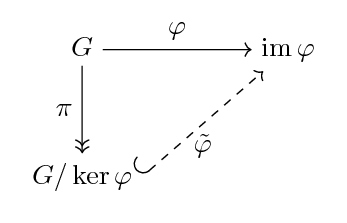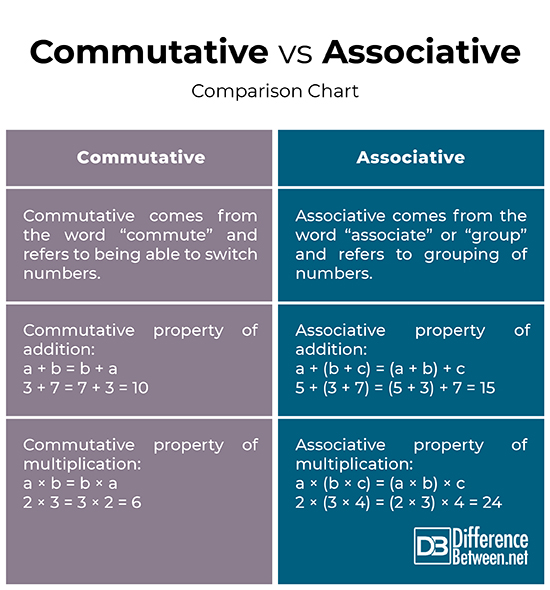Difference Between Commutative and Associative
Mathematics is a game of numbers and numbers are everywhere. And the rule of the game is the properties and rules associated with numbers. Properties help you calculate answers in your head quickly and easily. Properties are nothing but special rules that numbers follow. There are three basic properties of numbers that every math system obeys: Commutative, Associative, and Distributive properties. These properties are features of the four operations (add, subtract, multiply, and divide) that always apply regardless of the number you’re working with. But we will discuss only commutative and associative properties in the following article.
Both commutative and associative properties are rules applied to addition and multiplication operations. These properties are laws used in algebra to help solve problems. The commutative property comes from the term “commute” which means move around and it refers to being able to switch numbers that you’re adding or multiplying. The associative property comes from the word “associate” or “group” and it refers to grouping of three or more numbers using parentheses, regardless of how you group them. The result remains the same, no matter how you re-group the numbers. Let’s take a look at the two properties to better understand how they work.

What is Commutative?
For example; we know that adding 2 and 5 gives the same answer as adding 5 and 2. The order of the numbers in an addition problem can be changed without changing the result. This thing about numbers and addition is called the commutative property of addition. So, we can say addition is a commutative operation. Similarly, multiplication is a commutative operation.
Commutative property of addition:
a + b = b + a
3 + 4 = 7 is the same as 4 + 3 = 7
The result will be the same regardless of the order of the numbers.
Commutative property of multiplication:
a × b = b × a
3 × 7 = 21 is the same as 7 × 3 = 21
Likewise, the result will be the same regardless of the order of the numbers.

What is Associative?
Associative is yet another property we use has to do with re-grouping. For instance, when adding 2 + 3 + 5, we can either add 2 and 3 first and then add 5, or we can add 3 and 5 first and then the 2. Mathematically, it looks like this: 2 + 3 + 5 = 2 + (3 + 5) = (2 +3) + 5. Operations that behave in this manner are called associative operations. The result remains the same even if we change the grouping of numbers.
Associative property of addition:
a + (b + c) = (a + b) + c = a + b + c
1 + (2 +3) = (1 +2) + 3 = 6
The result remains the same, no matter how you group the numbers.
Associative property of multiplication:
a × (b × c) = (a × b) × c
2 × (3 × 4) = 2 × 12 = 24
(2 × 3) × 4 = 6 × 4 = 24
So, the grouping in the numbers does not change the result.
Difference between Commutative and Associative
Meaning
– The commutative property comes from the term “commute” which means ‘move around’ and it refers to being able to switch numbers that you’re adding or multiplying regardless of the order of the numbers. The associative property, on the other hand, comes from the word “associate” or “group” and it refers to grouping of three or more numbers using parentheses, regardless of how you group them. The result will be the same, no matter how you re-group the numbers or variables.
Rule
– The commutative rule of addition states, a + b = b + a, which means adding a and b gives the same result as adding b and a. The orders can be changes without changing the result. This rule of addition is called the commutative property of addition. Similarly, multiplication is a commutative operation which means a × b will give the same result as b × a. The associative property, on the other hand, is the rule that refers to grouping of numbers. The associative rule of addition states, a + (b + c) is the same as (a + b) + c. Likewise, the associative rule of multiplication says a × (b × c) is the same as (a × b) × c.
Example
– The commutative property of addition: 1 + 2 = 2 +1 = 3
The commutative property of multiplication: 2 × 3 = 3 × 2 = 6
The associative property of addition: 5 + (3 + 7) = (5 + 3) + 7 = 15
The associative property of multiplication: 5 × (2 × 4) = (5 × 2) × 4 = 40
Commutative vs. Associative: Comparison Chart

Summary
In a nutshell, the commutative property is not to confuse with the associative property. The commutative property states that it’s okay to change of the order of the numbers in addition and multiplication operations because the result will be the same, no matter the order. The associative property, on the other hand, states that the result will be the same, no matter how you group the number or variables in addition/multiplication operations.
- Difference Between Caucus and Primary - June 18, 2024
- Difference Between PPO and POS - May 30, 2024
- Difference Between RFID and NFC - May 28, 2024
Search DifferenceBetween.net :
Leave a Response
References :
[0]Image credit: https://upload.wikimedia.org/wikipedia/commons/thumb/d/dc/Group_associative_categories.svg/500px-Group_associative_categories.svg.png
[1]Image credit: http://latex-cookbook.net/media/cookbook/examples/PNG/commutative-diagram.png
[2]McKeague, Charles P. Intermediate Algebra with Trigonometry. Cambridge, Massachusetts: Academic Press, 2014. Print
[3]Zegarelli, Mark. Basic Math and Pre-Algebra For Dummies. Hoboken, New Jersey: John Wiley & Sons, 2016. Print
[4]McKeague, Charles P. Beginning Algebra: A Text/Workbook. Amsterdam, Netherlands: Elsevier, 2014. Print
